Final report for FS14-281
Project Information
Investigations for an organic cultivation method that allows for year-round harvesting of asparagus in South Texas resulted in substantial success via the ‘cut back and harvest’ method. Under this method, asparagus ferns were pruned back every two months to try to extend and maintain a continuous production of asparagus throughout the year. As the new spears emerge after being pruned, they were harvested for the two-month period. Furthermore, five cultivars of asparagus were examined to determine which perform better in South Texas weather conditions. Results of this research show that the cultivars from highest to lowest performing, based on the total weight of asparagus spears produced, were; Jersey Supreme, Jersey Knight, Mary Washington, Purple Passion, and UC 157. This research also showed that asparagus production in South Texas can have two distinct seasons, instead of only one: a primary season that peaks from March through May, and a secondary season that peaks September through November. This research shows that asparagus harvest in South Texas can be strong for 6 months, and can extend for 10 months, out of the year, with only two or three months of very low production, including January and August.
The demonstration of an extended, viable growing season for asparagus in the South would provide another crop option for southern agricultural producers. This option could be particularly beneficial to smaller-scale producers that direct market their crops locally over a period of several months. Asparagus is not typically grown commercially in the South because of hot weather conditions and a limited harvest season. This research tested five cultivars of asparagus for heat tolerance and established organic cultivation methods for asparagus in South Texas, and other warm areas of the South, that can provide near year-round production.
This project’s three research objectives were carried out simultaneously over the course of a 28-month data-collection period:
1. Develop an organic cultivation method that allows for year-round harvesting of asparagus in South Texas.
The steps necessary to accomplish this objective include:
a. Prune one replication of asparagus ferns below the soil surface to mimic die-back during dormancy and harvest emerging spears for a two-month period.
b. Prune the replication again 10 months after the first pruning.
c. Repeat steps a. and b. with the second replication of asparagus two months after the first replication was pruned. Continue with the third, fourth, and fifth replications, waiting two months before pruning each subsequent replication.
d. Collect yield data from each of the five cultivars of asparagus from each replication.
2. Test five cultivars of asparagus to determine which perform better in South Texas weather conditions.
3. Disseminate findings to local growers and growers throughout the South through outreach efforts.
Research
Investigations for an organic cultivation method that allows for year-round harvesting of asparagus in South Texas resulted in substantial success via the ‘cut back and harvest’ method. Under this method, asparagus ferns were pruned back every two months to try to extend and maintain a continuous production of asparagus throughout the year. As the new spears emerge after being pruned, they were harvested for the two-month period. Furthermore, five cultivars of asparagus were examined to determine which perform better in South Texas weather conditions.
From November 2014 through August 2017, trials for the organic cultivation of asparagus were conducted at a cooperator farm located near Lyford, Texas. Five different cultivars of asparagus were planted in five different replications at the Cooperator's field in February 2013. Each replication contains five plants of each cultivar. The asparagus was grown under organic conditions continuously since planted.
To mimic the die-back of asparagus ferns that occurs during dormancy in colder climates, asparagus ferns in the trial were cut below the soil surface every ten months. The replications were pruned back successively every two months to try to extend and maintain a more continuous production throughout the year. As the new spears emerged after pruning, they were harvested for the two-month period. Each asparagus replication of five asparagus cultivars was pruned every 10 months (at two-month intervals) during the 28-month project period. Limiting production to one harvest every ten months allowed the underground crowns to store more energy and produce a larger harvest the following year. This cultivation method proved to be successful for years 1 and 2 of the trial.
As shown below in Figure 1, every month of Year 1, with the exception of January 2015, yielded asparagus spears; however, there was considerable seasonal variation in production. The month that yielded the highest number of asparagus spears was June 2015, with 325 total asparagus spears harvested from the five cultivars.
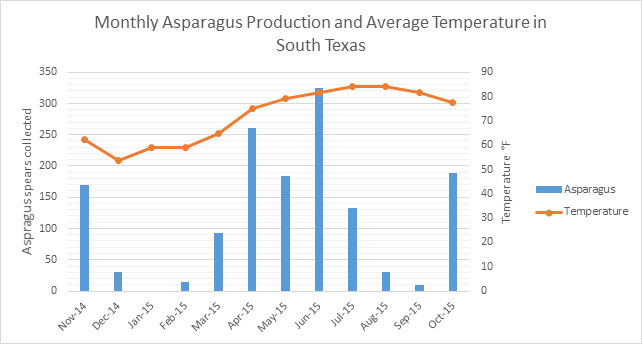 Figure 1. Year 1 monthly asparagus production in South Texas.
Figure 1. Year 1 monthly asparagus production in South Texas.
June 2015 was the month that produced the largest number of asparagus spears collected. January 2015 was the only month that did not produce any asparagus spears in this trial. The lowest production of asparagus correlates with the lowest and highest temperatures during the year.
Production of asparagus spears for Year 2 of the project (a 16-month period from May 2016 through August 2017) is shown in Figure 2. Year 2 produced similar results as Year 1 in terms of seasonal variation. However, Year 2 produced twice as much asparagus because the asparagus root crowns (planted in February 2013) were older, more mature, and more productive.
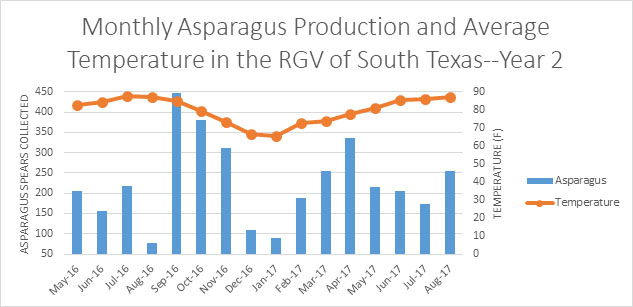 Figure 2. Year 2 monthly asparagus production in the Rio Grande Valley of South Texas.
Figure 2. Year 2 monthly asparagus production in the Rio Grande Valley of South Texas.
Five cultivars of asparagus were examined to determine which performed better under South Texas weather conditions. The five cultivars of asparagus planted in February 2013 included two New Jersey types—Jersey Knight and Jersey Supreme; one Washington type—Mary Washington; and two California types—Purple Passion and UC 157. To determine the better performing cultivars, the number and weight of the asparagus spears were documented. Spears were cut when they reached six inches or more in length.
Year 1 results for each asparagus cultivar are compared in Figure 3 and Year 2 results are shown in Figure 4. These results are based on the number of asparagus spears harvested.
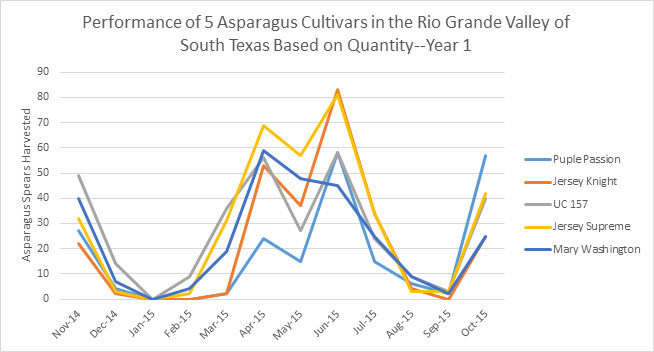
Figure 3. Year 1 performance of five different asparagus cultivars in the Rio Grande Valley of South Texas. The cultivars from the highest to the lowest performing, based on the total number of spears produced, were; Jersey Supreme, UC 157, Mary Washington, Jersey Knight, and Purple Passion.
Year 2 results for each asparagus cultivar are compared in Figure 4 on the following page. The chart illustrates that seasonal growth trend is similar across all the cultivars; with highest production in early Fall and Spring and lowest production in late Summer and Winter. However, the number of spears harvested varies greatly between cultivars. For example, at the two production highs, Jersey Supreme resulted in 127 and 125 spears harvested, but UC 157 resulted in only 76 and 42 spears harvested.
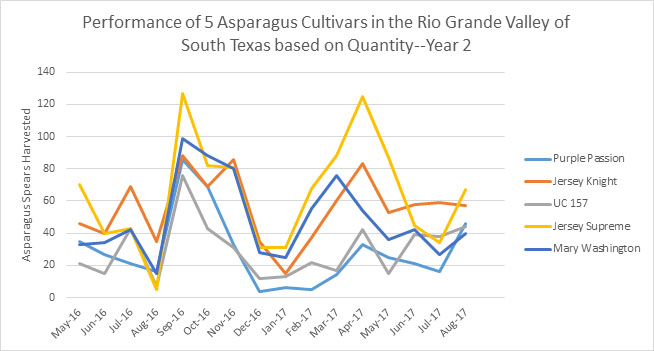
Figure 4. Year 2 performance of five different asparagus cultivars in the Rio Grande Valley of South Texas. The cultivars from the highest to the lowest performing, based on total number of spears produced were; Jersey Supreme, Jersey Knight, Mary Washington, UC 157, and Purple Passion.
Figure 5 shows the average weight per spear for each asparagus cultivar during Year 1, while Figure 6 shows the same information for Year 2, but also adds the number of spears harvested for each cultivar.

Figure 5. Year 1 average weight (g) per spear of harvested asparagus from the five examined cultivars.
As shown in Figure 6, the cultivars from highest to lowest performing, based on the number of asparagus spears produced, were; Jersey Supreme, Jersey Knight, Mary Washington, UC 157, and Purple Passion. The respective quantitative yields for the five cultivars were 1,024, 890, 774, 478, and 457, respectively. The average weight of the asparagus spears harvested from the five cultivars varied less in year 2 than in year 1. The cultivars from the highest to the lowest average weight were: Purple Passion, Jersey Knight, Mary Washington, Jersey Supreme, and UC 157. The respective average weight per spear for the five cultivars was: 13.9 g, 10.2 g, 9.7 g, 9.5 g, and 8.4 g.
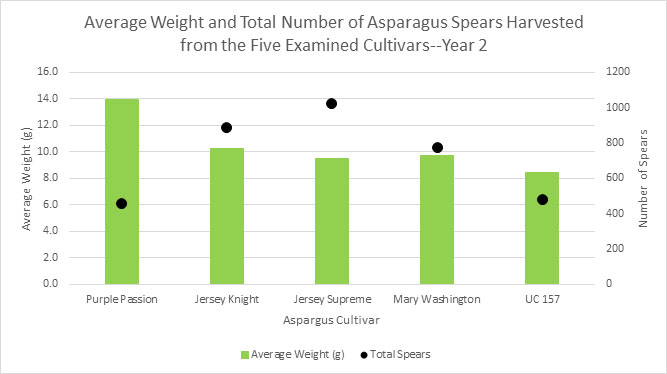 Figure 6. Year 2 average weight (g) per spear of harvested asparagus from the five examined cultivars.
Figure 6. Year 2 average weight (g) per spear of harvested asparagus from the five examined cultivars.
Year 2 asparagus production, in total pounds, for each asparagus cultivar is shown in Figure 7 below. The cultivars from highest to lowest performing were Jersey Supreme (20.1 lbs.), Jersey Knight (19.0 lbs.), Mary Washington (15.7 lbs.), Purple Passion (12.8 lbs.), and UC 157 (8.5 lbs.). The total number of spears produced by each asparagus cultivar during Year 2, in decreasing order, was: Jersey Supreme (1,024), Jersey Knight (890), Mary Washington (774), UC 157 (478), and Purple Passion (457). This production was over a 16-month period and each asparagus cultivar had a total planting of 25 linear feet. Projecting the total annual production per acre of each cultivar requires that production is determined for a 12-month period and 25 linear feet of planting is projected to 8,736 ft., assuming asparagus rows are spaced five feet apart. The ranking of asparagus cultivars for production in pounds per acre, based on Year 2 performance, is: Jersey Supreme (5,268 lbs.), Jersey Knight (4,980 lbs.), Mary Washington (4,115 lbs.), Purple Passion (3,355 lbs.), and UC 157 (2,228 lbs.).
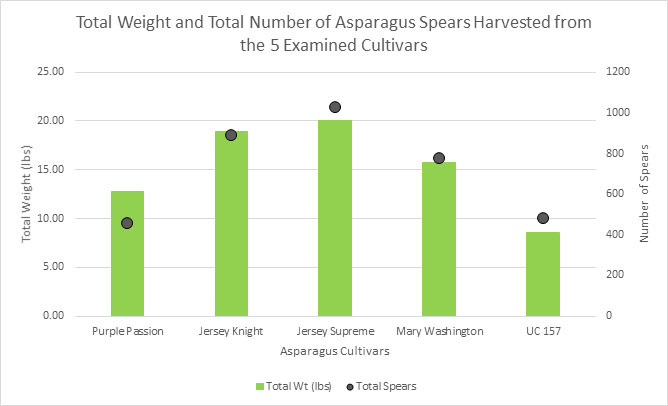 Figure 7. Year 2 total weight (lbs.) and total number of asparagus spears harvested from the 5 cultivars.
Figure 7. Year 2 total weight (lbs.) and total number of asparagus spears harvested from the 5 cultivars.
Educational & Outreach Activities
Participation Summary:
The results of this research project are planned to be publicized through five venues—the TMBC and SARA websites, video production and broadcasting, training events, a presentation at the Southern Sustainable Agriculture Working Group (SSAWG) conference, and a published article.
Learning Outcomes
Project Outcomes
Research results of this project suggest that asparagus has the potential to be a successful alternative crop for small-scale producers in subtropical South Texas and other areas of the South. However, the productive life of asparagus grown in South-Texas heat is not known. In cooler climates, a 10- to 15-year productive life for asparagus is not uncommon. The lifespan of asparagus could be reduced substantially as a result of South Texas heat. More research into the productive life of asparagus grown in hot South Texas needs to be done.
Throughout this 28-month project, the examined ‘cut-back and harvest’ method yielded positive results under organic conditions. Under this organic cultivation method, asparagus was harvested every month during the 28-month data-collection period, with the exception of January 2015. However, as the graphs in this report show, there was considerable varietal and seasonal differences in asparagus production. Whether it is economically viable to produce asparagus during the lower-production months will depend on seasonal price points. These research results provide valuable information with regard to asparagus production in areas of the South, and suggest that asparagus has the potential to be grown commercially in hot-weather environments. These research results also demonstrate that asparagus can provide an extended period of production and harvest in the South, though not year-round.
In addition, this research project identified better preforming asparagus cultivars under organic conditions in the South. The cultivars from the highest to lowest performing, based on total weight of each asparagus cultivar harvested, were; Jersey Supreme, Jersey Knight, Mary Washington, Purple Passion, and UC 157. This distinction of cultivars, along with the cultivation method examined, will provide small-scale growers in South Texas, and other areas of the South, with the methods they need to successfully grow asparagus and help them sustain the economic viability of their small farms by allowing them to direct market their asparagus over an extended season.
According to the University of California Cooperative Extension website, growers following good cultural practices should be able to expect the following asparagus yields:
( see http://sfp.ucdavis.edu/pubs/brochures/Asparagus/ )
• 500 lbs. per acre the first year after planting
• 1,000-1,500 lbs. per acre the second year
• 2,000 lbs. per acre the third year
• 3,000 lbs. per acre the fourth year
• 4,000 lbs. per acre the fifth year
The top producing variety in this research project, Jersey Supreme, produced 0.6 lbs. of asparagus spears per running foot, per year, of planted asparagus in its fourth year after planting. This is the equivalent of 5,268 lbs. of untrimmed asparagus spears per acre before the asparagus was mature (at five years). This compares very favorably to the expected yields, provided by UC Davis, of 3,000 lbs. per acre during the fourth year.
This UC Davis web site also states, “Asparagus should not be considered for commercial production where warm conditions result in the plant's growth all year.” While this research challenges this common perception, it must be remembered that this 28-month research project did not continue long enough to determine the longer-term effects of a hot sub-tropical climate on asparagus production and plant longevity.
Finally, the asparagus in this 28-month research project was organically grown. It is worth noting that no insecticides or herbicides were ever used on this asparagus during the 28-month project. This is very unusual for any crop in the sub-tropical Rio Grande Valley of South Texas. This asparagus never presented insect pressures. When the asparagus ferns were cut every 10 months, a two-inch layer of compost was spread on the asparagus beds. This compost provided the only fertilization used, insulated the root crowns, and suppressed weeds. Some limited weeding was required during the 10-month growing period for asparagus ferns.
While this research challenges the common perception that warm conditions are not appropriate for asparagus commercial production, it must be remembered that this 28-month research project did not continue long enough to determine the longer-term effects of a hot sub-tropical climate on asparagus production and plant longevity.